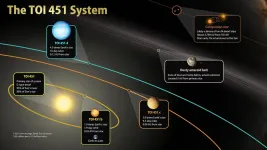(Press-News.org) FOR IMMEDIATE RELEASE
Scientists have yet to answer the age-old question of whether or how sound shapes the minds of fetuses in the womb, and expectant mothers often wonder about the benefits of such activities as playing music during pregnancy. Now, in experiments in newborn mice, scientists at Johns Hopkins report that sounds appear to change "wiring" patterns in areas of the brain that process sound earlier than scientists assumed and even before the ear canal opens.
The current experiments involve newborn mice, which have ear canals that open 11 days after birth. In human fetuses, the ear canal opens prenatally, at about 20 weeks gestation.
The findings, published online Feb. 12 in END
Study suggests sounds influence the developing brain earlier than previously thought
2021-02-12
ELSE PRESS RELEASES FROM THIS DATE:
Dark-skinned teens, females prime targets of acne's psychological fallout
2021-02-12
A more aggressive approach to treating acne that marries the disciplines of psychology and dermatology is needed, according to two UC Riverside psychology researchers.
They also assert that women and people with darker skin disproportionately suffer from acne's psychological impacts.
"Acne is pervasive, physically harmless, and painless, so we all-too-often underestimate its impacts as the quintessential nuisance of adolescence and puberty," said UCR psychology professor Misaki Natsuaki, who authored the paper along with Tuppett Yates, also a UCR psychology professor.
The insinuation, including by developmental scientists, can be that hurtful monikers such as "pizza face" and "crater face" are best shrugged off.
But psychological ...
NASA's TESS discovers new worlds in a river of young stars
2021-02-12
Using observations from NASA's Transiting Exoplanet Survey Satellite (TESS), an international team of astronomers has discovered a trio of hot worlds larger than Earth orbiting a much younger version of our Sun called TOI 451. The system resides in the recently discovered Pisces-Eridanus stream, a collection of stars less than 3% the age of our solar system that stretches across one-third of the sky.
The planets were discovered in TESS images taken between October and December 2018. Follow-up studies of TOI 451 and its planets included observations made in 2019 and 2020 using NASA's Spitzer Space Telescope, ...
Researchers propose that humidity from masks may lessen severity of COVID-19
2021-02-12
Masks help protect the people wearing them from getting or spreading SARS-CoV-2, the virus that causes COVID-19, but now researchers from the National Institutes of Health have added evidence for yet another potential benefit for wearers: The humidity created inside the mask may help combat respiratory diseases such as COVID-19.
The study, led by researchers in the NIH's National Institute of Diabetes and Digestive and Kidney Diseases (NIDDK), found that face masks substantially increase the humidity in the air that the mask-wearer breathes in. This higher level of humidity in inhaled air, the researchers suggest, could help explain why wearing masks has been linked to lower disease severity in people infected with SARS-CoV-2, because hydration of the respiratory ...
Disease epidemic possibly caused population collapse in Central Africa 1600-1400 years ago
2021-02-12
A new study published in the journal Science Advances shows that Bantu-speaking communities in the Congo rainforest underwent a major population collapse from 1600 to 1400 years ago, probably due to a prolonged disease epidemic, and that significant resettlement did not restart until around 1000 years ago. These findings revise the population history of no less than seven present-day African countries (Cameroon, Central African Republic, Democratic Republic of the Congo, Republic of the Congo, Gabon, Equatorial Guinea, and Angola) and challenges the commonly held belief that the settlement of Central Africa by Bantu-speaking communities was a continuous process from about 4000 years ago until the start of the transatlantic ...
'See through soil' could help farmers deal with future droughts
2021-02-12
In research that may eventually help crops survive drought, scientists at Princeton University have uncovered a key reason that mixing material called hydrogels with soil has sometimes proven disappointing for farmers.
Hydrogel beads, tiny plastic blobs that can absorb a thousand times their weight in water, seem ideally suited to serve as tiny underground reservoirs of water. In theory, as the soil dries, hydrogels release water to hydrate plants' roots, thus alleviating droughts, conserving water, and boosting crop yields.
Yet mixing hydrogels into farmers' fields has had spotty results. Scientists have struggled to explain these uneven performances in large part because soil--being opaque --has thwarted attempts at observing, analyzing, and ultimately improving hydrogel ...
ACC urges COVID-19 vaccine prioritization for highest risk heart disease patients
2021-02-12
COVID-19 vaccine prioritization should prioritize those with advanced cardiovascular (CVD) disease over well-managed CVD disease, according to an American College of Cardiology (ACC) health policy statement published in the Journal of the American College of Cardiology (JACC). All CVD patients face a higher risk of COVID-19 complications and should receive the vaccine quickly, but recommendations in this paper serve to guide clinicians in prioritizing their most vulnerable patients within the larger CVD group, while considering disparities in COVID-19 outcomes among different racial/ethnic groups and socioeconomic ...
New class of drug leads to 30% reduced risk of death for bladder cancer patients
2021-02-12
A new type of drug that helps target chemotherapy directly to cancer cells has been found to significantly increase survival of patients with the most common form of bladder cancer, according to results from a phase III clinical trial led in the UK by Queen Mary University of London and Barts Health NHS Trust.
The results are published in the New England Journal of Medicine and were presented at the 2021 American Society of Clinical Oncology's Genitourinary Cancers Symposium.
Urothelial cancer is the most common type of bladder cancer (90 percent of cases) and can also be found in the renal pelvis (where urine collects inside the kidney), ureter (tube that connects the kidneys ...
More trees do not always create a cooler planet, Clark University geographer finds
2021-02-12
WORCESTER, Mass. -- New research by Christopher A. Williams, an environmental scientist and professor in Clark University's Graduate School of Geography, reveals that deforestation in the U.S. does not always cause planetary warming, as is commonly assumed; instead, in some places, it actually cools the planet. A peer-reviewed study by Williams and his team, "Climate Impacts of U.S. Forest Loss Span Net Warming to Net Cooling," published today (Feb. 12) in Science Advances. The team's discovery has important implications for policy and management efforts that are turning to forests to mitigate climate change.
It ...
Star-shaped brain cells may be linked to stuttering
2021-02-12
RIVERSIDE, Calif. -- Astrocytes -- star-shaped cells in the brain that are actively involved in brain function -- may play an important role in stuttering, a study led by a University of California, Riverside, expert on stuttering has found.
"Our study suggests that treatment with the medication risperidone leads to increased activity of the striatum in persons who stutter," said Dr. END ...
Young planets with teenage sun give space studies a lift
2021-02-12
HANOVER, N.H. - February 12, 2021 - A newly discovered planetary system will provide researchers with the rare chance to study a group of growing planets, according to research co-led by Dartmouth.
The new system, named TOI 451, is made up of at least three neighboring planets that orbit the same sun. The planets range in size between that of Earth and Neptune.
According to the research team, NASA's Hubble Space Telescope and its planned successor, the James Webb Space Telescope, can be used to study the atmosphere of each planet. Such research could lead to information on how planetary systems like our own solar system evolve.
"The sun in this planetary system is very similar to our own sun, but much younger," ...




